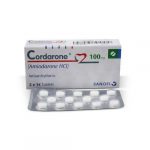
Angiotensin II Receptor Blockers vs. Calcium Channel Blockers
Angiotensin II receptor blockers (ARBs) control high blood pressure, heart failure, and kidney failure in people with diabetes or high blood pressure. ARBs may prevent diabetes, reduce the risk of stroke in patients with high blood pressure and an enlarged heart, and prevent the recurrence of atrial fibrillation. Angiotensin II is a potent chemical formed in the blood that causes muscles surrounding blood vessels to contract, narrowing the vessels. ARBs prevent angiotensin II from binding to receptors on the muscles surrounding blood vessels, enlarging the vessels and reducing blood pressure.
Calcium channel blockers (CCBs) treat high blood pressure, angina, and abnormal heart rhythms. They may also be used after a heart attack. CCBs dilate the arteries, reducing pressure and making it easier for the heart to pump blood. This reduces the heart’s need for oxygen, relieving or preventing angina. CCBs also treat high blood pressure and certain types of abnormally rapid heart rhythms.
QUESTION
What are the side effects of ARBs and CCBs?
ARBs
ARBs are well tolerated. Common side effects include:
- cough
- elevated potassium levels in the blood (hyperkalemia)
- low blood pressure
- dizziness
- headache
- drowsiness
- diarrhea
- abnormal taste sensation
- rash
- orthostatic hypotension
- fatigue
- indigestion
- increased blood glucose levels
- flu-like symptoms
- sinusitis
- bronchitis
- upper respiratory tract infections
Cough occurs less often with ARBs compared to ACE inhibitors.
- Serious side effects of ARBs:
- • kidney failure
- • liver failure
- • serious allergic reactions
- • decrease in white blood cells
- • decrease in blood platelets
- • swelling of tissues
- • reports of rhabdomyolysis (muscle destruction)
- • individuals with narrow arteries supplying the kidneys or previous severe reactions to ARBs should avoid them
- • ARBs have been associated with sexual dysfunction
CCBs
The most common side effects of CCBs are:
- Constipation
- Nausea
- Headache
- Rash
- Edema
- Low blood pressure
- Drowsiness
- Dizziness
Liver dysfunction and overgrowth of gums also occur.
When diltiazem or verapamil are given to individuals with heart failure, symptoms may worsen because these drugs reduce the heart’s ability to pump blood.
Like other blood pressure medications, CCBs are associated with sexual dysfunction.
What drugs interact with ARBs and CCBs?
ARBs
- ARBs have few interactions with other drugs.
- ARBs may increase blood levels of potassium and interact with drugs that increase potassium levels.
- ARBs may increase blood concentration and side effects of lithium.
- Rifampin reduces blood levels of losartan, and fluconazole reduces the conversion of losartan to its active form.
- ARBs should not be combined with ACE inhibitors, aliskiren, or certain other drugs.
CCBs
Most interactions of CCBs occur with verapamil or diltiazem. These drugs decrease the elimination of certain drugs by the liver, potentially leading to toxicity.
Grapefruit juice may elevate blood concentrations of certain CCBs. It should not be consumed within a certain timeframe of taking affected CCBs.
What are the different types of ARBs and CCBs?
ARBs
The available ARBs are:
- azilsartan
- candesartan
- eprosartan
- irbesartan
- telmisartan
- valsartan
- losartan
- olmesartan
- entresto
- byvalson
ARBs are similar in actions and side effects, but they differ in elimination and distribution throughout the body.
- Some ARBs need to be converted to an active form in the body to lower blood pressure.
- In some studies, irbesartan and candesartan reduced blood pressure better than losartan.
CCBs
The approved calcium channel blockers include:
- amlodipine
- amlodipine and atorvastatin
- amlodipine and benazepril
- amlodipine and valsartan
- amlodipine and telmisartan
- amlodipine and olmesartan
- amlodipine and olmesartan and hydroclorothiazide
- amlodipine and aliskiren and hydroclorothiazide
- amlodipine and perindopril
- clevidipine
- diltiazem
- felodipine
- isradipine
- nicardipine
- nimodipine
- nisoldipine
- verapamil
Calcium channel blockers differ in duration of action, elimination from the body, and their effects on heart rate and contraction.
By clicking "Submit," I agree to the MedicineNet Terms and Conditions and Privacy Policy. I also agree to receive emails from MedicineNet and understand that I may opt out of MedicineNet subscriptions at any time.
Summary
Angiotensin II receptor blockers (ARBs) and calcium channel blockers (CCBs) are used to treat high blood pressure, heart failure, and other cardiovascular conditions. ARBs can also prevent diabetes, reduce stroke risk, and prevent atrial fibrillation recurrence. CCBs also treat angina, abnormal heart rhythms, and can be used after a heart attack.


